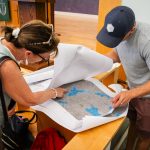LYNN – State and local leaders gathered at Hawthorne By-The-Sea Wednesday for a panel discussion on Lynn and Swampscott’s collaborative water treatment efforts to maintain the health of King’s Beach.
The event was hosted by the Greater Lynn Chamber of Commerce, and the panel consisted of Swampscott Interim Town Administrator Gino Cresta, Lynn Ward 3 Councilor Coco Alinsug, Rep. Jenny Armini and Sen. Brendan Crighton.
Armini pointed out that the collaboration between Lynn and Swampscott is not common.
“What’s really important and exciting about this is you have – and this is so unusual – two communities coming together to solve a problem using cutting-edge technology. I mean, really everyone should give themselves a pat on the back for this because you don’t see that often. You don’t see that level of collaboration among federal, state, and local partners,” Armini said.
She continued, “My understanding is it was a finger-pointing exercise (between Lynn and Swampscott) before then as to who was to blame and what to do, and the two communities just decided, ‘We’re not doing that anymore. We’re going to sit down and figure this out,’ and that’s really extraordinary.”
Cresta said “we are 10 weeks into” the three month pilot program. He added that “we’re collecting plenty of data,” and those results can be found on the City of Lynn’s website in the King’s Beach section.
One community member asked the panel how the machinery that is filtering the water works. Cresta took the lead on answering.
“There’s a weir wall on the Lynn side, and there’s a weir wall on the Swampscott side. It’s stopping the flow coming down from Stacy’s Brook and both communities. There’s two pumps in there, and the pumps pump the water that’s being stopped into the UV unit there, and it’s being treated with ultraviolet light, which kills the bacteria,” Cresta explained.
Another community member asked how progress is being measured. To answer, Cresta said, “That’s the reason why data is so important for this.” He added that the data is “how we’re measuring our success.”
Valerie Vong, Lynn Mayor Jared C. Nicholson’s communications and strategic initiatives manager, said, “We do daily sampling, and all the data is online. We have an interactive dashboard … and we also have a spreadsheet, so it’s really accessible. We talk about bacteria levels, and we’re also going to be doing air quality measurements, which is from the generator.”
Lynn resident Steve Harrington, who lives in the immediate abutting area to these machines, voiced his frustrations with having to “live with the diesel engine 24/7,” which he said equates to there being “an 18-wheeler underneath your bedroom 24/7” that doesn’t stop.
“Right now, all of us (abutters) have banners asking, begging, please do not run these machines at night so we can get some sleep,” he said. “We can’t open our windows. We can’t open our doors. I know this sounds very NIMBY (Not In My Backyard), and it’s only (for) three months, however, that constant drone is there all the time. We have people in our neighborhood who have moved their bedrooms to the back of the house (due to the noise).”
He added that, when considering the ambient decibel level in the neighborhood, the noise is “at an illegal level.”
“I walked around at midnight and took readings with a decibel reader. It was between 38 and 42 on a scale of 100. Legally, any project like this can go 10 decibels above ambient,” Harrington said. “Right now, in our house, we’re between 58 and 62, which is 28 over. If you’re in between the two machines at 20 feet … the decibel level can go up. It’s between 68 and 71, so it’s not like we’re complaining about a low-level decibel. This is an illegal decibel level.”
Cresta said the Massachusetts Department of Environmental Protection has been contacted about this noise issue, but “the whole group is on vacation this week.” Cresta added, “They’ll be coming up next week to do all the testing to find out if we are exceeding those (noise) levels.”
Crighton concluded by saying, “I think this is what should be happening in the public sphere and in government: people coming together, not agreeing on everything, not knowing all the answers, not looking for easy answers, expressing disagreement and having a civil discussion here. It’s certainly an example to set for your country, if not for the world, on how we respond to get things done to benefit our whole community.”




